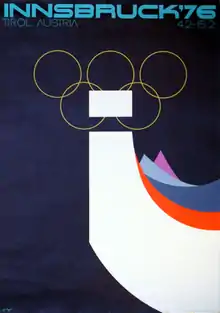1976 Winter Olympics
The 1976 Winter Olympics, officially known as the XII Olympic Winter Games (French: XIIes Jeux olympiques d'hiver, German: Olympische Winterspiele 1976), were a winter multi-sport event which was celebrated February 4–15, 1976 in Innsbruck, Austria. It was the second time the Tyrolean city hosted the Games, which were awarded to Innsbruck after Denver, the original host city, withdrew in 1972.
 Emblem of the 1976 Winter Olympics[lower-alpha 1] | |||
| Host city | Innsbruck, Austria | ||
|---|---|---|---|
| Nations | 37 | ||
| Athletes | 1,123 (892 men, 231 women) | ||
| Events | 37 in 6 sports (10 disciplines) | ||
| Opening | 4 February | ||
| Closing | 15 February | ||
| Opened by | |||
| Cauldron | |||
| Stadium | Bergisel | ||
| Winter | |||
| |||
| Summer | |||
| |||
Host selection
The cities of Denver, Colorado, United States; Sion, Switzerland; Tampere, Finland; and Vancouver (with the Garibaldi mountains), British Columbia, Canada, made bids for the Games. The chart below displays the vote count for the 69th IOC meeting at Amsterdam, Netherlands, on May 12, 1970.
| Original 1976 Winter Olympics bidding results[1] | ||||||
|---|---|---|---|---|---|---|
| City | Country | Round 1 | Round 2 | Round 3 | ||
| Denver | 29 | 29 | 39 | |||
| Sion | 18 | 31 | 30 | |||
| Tampere | 12 | 8 | — | |||
| Vancouver—Garibaldi | 9 | — | — | |||
The selection process for the 1976 Winter Olympics consisted of four bids, and saw Denver, United States, selected ahead of Sion, Switzerland; Tampere, Finland; and Vancouver, British Columbia, Canada. The selection was made at the 70th IOC Session in Amsterdam on 12 May 1970.[1] In a statewide referendum on 7 November 1972, Colorado voters rejected funding for the games, and for the only time a city awarded the Games rejected them.[2] Denver officially withdrew on 15 November, and the IOC then offered the games to Whistler, British Columbia, Canada, but they too declined owing to a change of government following elections. Whistler would go on to be associated with neighbouring Vancouver's successful bid for the 2010 games. Salt Lake City offered to host the games, but the IOC, still reeling from the Denver rejection, declined and selected Innsbruck to host the 1976 Winter Olympics, which had hosted the 1964 Winter Olympics games twelve years earlier, on 5 February 1973. Salt Lake City would then host the Winter Olympics in 2002.
Mascot
The mascot of the 1976 Winter Olympics was Schneemann a snowman in a red Tyrolean hat. Designed by Walter Pötsch, Schneeman was purported to represent the 1976 Games as the "Games of Simplicity". It was also regarded as a good-luck charm, to avert the dearth of snow that had marred the 1964 Winter Olympics in Innsbruck.[3][4]
Highlights

- First Games under the presidency of Michael Morris, 3rd Baron Killanin
- Austrian favorite Franz Klammer won the men's downhill event in alpine skiing in 1:45.73, after great pressure from his country and defending champion Bernhard Russi of Switzerland.
- Dorothy Hamill of the US won the gold in figure Skating, and inspired the popular "wedge" haircut.[5]
- Elegant British figure skater John Curry altered his routine to appeal to Olympic judges, winning gold.[6]
- American figure skater Terry Kubicka attempted – and completed – a dangerous backflip in figure skating.
- Rosi Mittermaier of West Germany nearly swept the women's alpine skiing events, earning two golds and a silver, missing the third gold by 0.13 seconds.[7]
- Soviet speed skater Tatiana Averina won four medals.[8]
- In the 4-man bobsled, the East German team won the first of three consecutive titles.
- The USSR won its fourth straight ice hockey gold medal; for the second consecutive Olympics, Canada refused to send a team, protesting the rules that allowed the USSR to field professional players while limiting Canada to amateurs. Sweden also joined the boycott.[9]
- Sports technology, in the guise of innovative perforated skis, sleek hooded suits and streamlined helmets appeared in alpine skiing, speed skating and ski jumping, making headlines in Innsbruck.[10]
- A second cauldron for the Olympic flame was built to represent the 1976 Games. Both it and the cauldron from the 1964 games were lit together.
- Bobsleigh and luge competed on the same track for the first time ever.
- Galina Kulakova of the Soviet Union finished 3rd in the women's 5 km ski event, but was disqualified due to a positive test for banned substance ephedrine. She claimed that this was a result of using the nasal spray that contained the substance. Both the FIS and the IOC allowed her to compete in the 10 km and the 4×5 km relay.[11] This was the first stripped medal at the Winter Olympics.
- The Austrian anthem was played three times at the closing ceremony during the beginning, the victory ceremony and the handover ceremony to honor the three verses of the anthem.
Venues

- Axamer Lizum – Alpine skiing except men's downhill
- Bergiselschanze – Ski jumping (large hill), Opening Ceremonies
- Eisschnellaufbahn – Speed skating
- Kombinierte Kunsteisbahn für Bob-Rodel Igls – Bobsleigh, Luge
- Messehalle – Ice hockey
- Olympiahalle – Figure skating, Ice hockey, Closing Ceremonies
- Patscherkofel – Alpine skiing (men's downhill)
- Seefeld – Biathlon, Cross-country skiing, Nordic combined, Ski jumping (normal hill)
Medals awarded
There were 37 events contested in 6 sports (10 disciplines). Ice dance made its Olympic debut. See the medal winners, ordered by sport:
|
|
Participating nations
37 nations participated in the 1976 Winter Olympic Games. The games marked the final time the Republic of China (Taiwan) participated under the Republic of China flag and name. After most of the international community recognized the People's Republic of China as the legitimate government of all China, the ROC was forced to compete under the name Chinese Taipei, under an altered flag and to use its National Banner Song instead of its national anthem. Andorra and San Marino participated in their first Winter Olympic Games.
| Participating National Olympic Committees |
|---|
|
Medal count
These are the top ten nations that won medals at the 1976 Winter Games.
* Host nation (Austria)
| Rank | Nation | Gold | Silver | Bronze | Total |
|---|---|---|---|---|---|
| 1 | 13 | 6 | 8 | 27 | |
| 2 | 7 | 5 | 7 | 19 | |
| 3 | 3 | 3 | 4 | 10 | |
| 4 | 3 | 3 | 1 | 7 | |
| 5 | 2 | 5 | 3 | 10 | |
| 6 | 2 | 4 | 1 | 7 | |
| 7 | 2 | 2 | 2 | 6 | |
| 8 | 1 | 3 | 1 | 5 | |
| 9 | 1 | 2 | 3 | 6 | |
| 10 | 1 | 2 | 1 | 4 | |
| Totals (10 nations) | 35 | 35 | 31 | 101 | |
See also
- 1976 Winter Paralympics
- 1976 Summer Paralympics
- 1976 Summer Olympics
- Olympic Games celebrated in Austria
- 1964 Winter Olympics – Innsbruck
- 1976 Winter Olympics – Innsbruck
- 2012 Winter Youth Olympics – Innsbruck
References
Notes
- The emblem represents the coat of arms of Innsbruck, which shows the bridge on the Inn River that connects the old town and the Hötting district. The bridge and the Olympic rings symbolize the link that ties the many peoples of the world with friendship through the Olympic Games. The top of the coat of arms has two indents which match two of the Olympic rings and represent the 1964 and 1976 Winter Games which Innsbruck celebrates.
Citations
- "Past Olympic host city election results". GamesBids. Archived from the original on March 17, 2011. Retrieved March 17, 2011.
- Sanko, John (October 12, 1999). "Colorado only state ever to turn down Olympics". Rocky Mountain News. Archived from the original on June 1, 2009. Retrieved March 16, 2011.
- International Olympic Committee. "Olympic Winter Games Mascots from Innsbruck 1976 to Sochi 2014". Archived from original June 3, 2014. Retrieved April 10, 2017.
- Australian Olympic Committee. "A history of winter mascots". Retrieved April 10, 2017.
- Dorothy Hamill bio. Factmonster.com. Retrieved on July 7, 2011.
- Olympic.org
- Infoplease. Infoplease (February 1, 2009). Retrieved on July 7, 2011.
- Kiat.net Archived March 13, 2008, at the Wayback Machine. Kiat.net. Retrieved on July 7, 2011.
- http://webarchive.iihf.com/iihf-home/the-iihf/100-year-anniversary/100-top-stories/story-17/
- CBC.CA. CBC.CA. Retrieved on July 7, 2011.
- Evans, Hilary; Gjerde, Arild; Heijmans, Jeroen; Mallon, Bill; et al. "1976 Winter Olympics". Olympics at Sports-Reference.com. Sports Reference LLC. Archived from the original on 20 January 2011.
External links
| Wikimedia Commons has media related to 1976 Winter Olympics. |
- "Innsbruck 1976". Olympic.org. International Olympic Committee.
- The Official Report of the XIIth Winter Olympic Games 1976 at Innsbruck – from LA84Foundation at the Wayback Machine (archived November 12, 2013)
- Present photos of Innsbruck Olympic sites at the Wayback Machine (archived March 23, 2007)
- Rocky Mountain News – Colorado only state ever to turn down Olympics – October 12, 1999 at the Wayback Machine (archived June 1, 2009)
| Preceded by Sapporo |
Winter Olympics Innsbruck XII Olympic Winter Games (1976) |
Succeeded by Lake Placid |